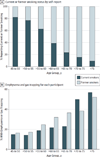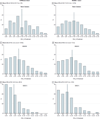Clinical and Radiologic Disease in Smokers With Normal Spirometry
- PMID: 26098755
- PMCID: PMC4564354
- DOI: 10.1001/jamainternmed.2015.2735
Clinical and Radiologic Disease in Smokers With Normal Spirometry
Erratum in
-
Error in Author Affiliation. Clinical and Radiologic Disease in Smokers With Normal Spirometry.JAMA Intern Med. 2015 Sep;175(9):1588. doi: 10.1001/jamainternmed.2015.4706. JAMA Intern Med. 2015. PMID: 26348527 No abstract available.
Abstract
Importance: Airflow obstruction on spirometry is universally used to define chronic obstructive pulmonary disease (COPD), and current or former smokers without airflow obstruction may assume that they are disease free.
Objective: To identify clinical and radiologic evidence of smoking-related disease in a cohort of current and former smokers who did not meet spirometric criteria for COPD, for whom we adopted the discarded label of Global Initiative for Obstructive Lung Disease (GOLD) 0.
Design, setting, and participants: Individuals from the Genetic Epidemiology of COPD (COPDGene) cross-sectional observational study completed spirometry, chest computed tomography (CT) scans, a 6-minute walk, and questionnaires. Participants were recruited from local communities at 21 sites across the United States. The GOLD 0 group (n = 4388) (ratio of forced expiratory volume in the first second of expiration [FEV1] to forced vital capacity >0.7 and FEV1 ≥80% predicted) from the COPDGene study was compared with a GOLD 1 group (n = 794), COPD groups (n = 3690), and a group of never smokers (n = 108). Recruitment began in January 2008 and ended in July 2011.
Main outcomes and measures: Physical function impairments, respiratory symptoms, CT abnormalities, use of respiratory medications, and reduced respiratory-specific quality of life.
Results: One or more respiratory-related impairments were found in 54.1% (2375 of 4388) of the GOLD 0 group. The GOLD 0 group had worse quality of life (mean [SD] St George's Respiratory Questionnaire total score, 17.0 [18.0] vs 3.8 [6.8] for the never smokers; P < .001) and a lower 6-minute walk distance, and 42.3% (127 of 300) of the GOLD 0 group had CT evidence of emphysema or airway thickening. The FEV1 percent predicted distribution and mean for the GOLD 0 group were lower but still within the normal range for the population. Current smoking was associated with more respiratory symptoms, but former smokers had greater emphysema and gas trapping. Advancing age was associated with smoking cessation and with more CT findings of disease. Individuals with respiratory impairments were more likely to use respiratory medications, and the use of these medications was associated with worse disease.
Conclusions and relevance: Lung disease and impairments were common in smokers without spirometric COPD. Based on these results, we project that there are 35 million current and former smokers older than 55 years in the United States who may have unrecognized disease or impairment. The effect of chronic smoking on the lungs and the individual is substantially underestimated when using spirometry alone.
Conflict of interest statement
Figures


Comment in
-
Smoking, Not COPD, as the Disease.N Engl J Med. 2016 May 12;374(19):1885-6. doi: 10.1056/NEJMe1515508. N Engl J Med. 2016. PMID: 27168438 No abstract available.
References
-
- Tomar SL, Asma S. Smoking-attributable periodontitis in the United States: findings from NHANES III: National Health and Nutrition Examination Survey. J Periodontol. 2000;71(5):743–751. - PubMed
-
- Behavioral Risk Factor Surveillance System. [Accessed May 15, 2015];Smoking exposures in the United States. 2013 http://www.cdc.gov/brfss/annual_data/annual_data.htm.
-
- Xu JQ, Kochanek KD, Murphy SL, Tejada-Vera B. National Vital Statistics Reports. Hyattsville, MD: National Center for Health Statistics; 2010. [Accessed May 11, 2015]. Deaths: Final Data for 2007. http://www.cdc.gov/nchs/data/nvsr/nvsr58/nvsr58_19.pdf. - PubMed
-
- The 2004 United States Surgeon General’s report: the health consequences of smoking. N S W Public Health Bull. 2004;15(5–6):107. - PubMed
-
- National Center for Chronic Disease Prevention and Health Promotion (US) Office on Smoking and Health. The Health Consequences of Smoking: 50 Years of Progress: A Report of the Surgeon General. Atlanta, GA: Centers for Disease Control and Prevention; 2014. - PubMed
Publication types
MeSH terms
Grants and funding
LinkOut - more resources
Full Text Sources
Other Literature Sources
Medical

